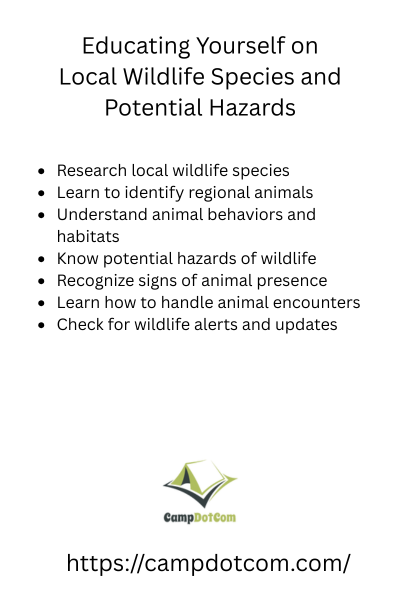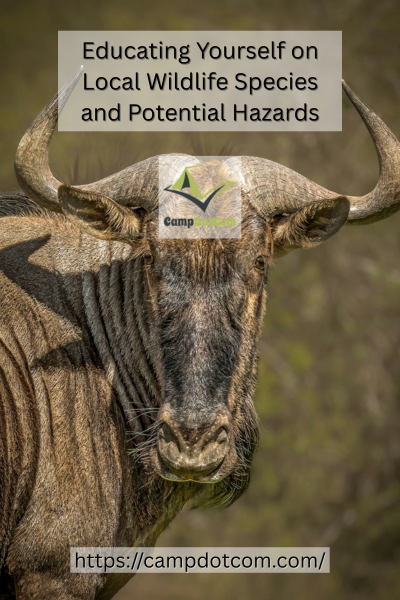Learning about the local wildlife and any possible dangers is not just about staying safe. It is also about making your camping trip more enjoyable, more relaxing, and a lot less stressful.
Let me share a quick story. A few years back, I went camping in a gorgeous, thick forest out west. Picture this: the sun was going down, the campfire was gently crackling, and I was getting comfortable in my hammock. Then I heard a strange rustling sound right behind my tent. My heart nearly sank to my toes. Luckily, it was just a curious raccoon, but it could have been something much bigger. That was the moment I realized how little I actually knew about the animals in that area. I decided I would never let that happen again.
Read More About Educating Yourself on Local Wildlife Species and Potential Hazards

Why Even Bother Learning About Wildlife?
You might be thinking, “Isn’t this what park rangers are for?” Fair question—but no, not really.
As an Amazon Associate, I earn from qualifying purchases. Some of the links in this article are affiliate links. This means that, at zero cost to you, I will earn an affiliate commission if you click through the link and finalize a purchase.
Educating yourself on local wildlife species and potential hazards helps you stay one step ahead. Some animals look cute and harmless until you find out they carry diseases or get aggressive when approached. Others might just ruin your food stash (I’m looking at you, squirrels and chipmunks). Then there are plants that seem totally normal but can cause nasty skin reactions.
Knowing what’s out there gives you a sense of control. You’ll feel more confident setting up your camp, taking hikes, or even just walking to the camp toilet in the dark (we’ve all been there).
More Things to Know About Educating Yourself on Local Wildlife Species and Potential Hazards

Start With Research—Before You Pack
Before visiting a new campsite, I like to take about 30 minutes to learn about the wildlife that lives in the area. Nothing too in depth, just the basics. Are there snakes around? Could there be bears? Are there any venomous insects I should keep an eye out for?
You do not need to memorize a whole field guide to prepare. A quick look at the park’s website or a local wildlife group’s page can give you plenty of useful information. Most will share what animals you might see and tips for staying safe.
Don’t Overlook the Small Stuff
When we talk about “wildlife hazards,” we usually picture bears or mountain lions. But honestly? The smaller stuff gets you more often.
Like ticks. Ugh. I’ve pulled more ticks off myself than I care to admit, and that’s even after wearing long pants. Then there are poisonous plants like poison ivy, oak, or sumac. Or swarms of mosquitoes that will eat you alive if you’re not prepared.
Educating yourself on local wildlife species and potential hazards includes the bugs, plants, and even the water sources. Not all streams are safe to drink from, no matter how crisp and clear they look.
Talk to the Locals (and Listen to the Signs)
One of my favorite things to do at a campsite is chat with the ranger or local camp host. These folks have seen it all—like that one time a hiker left their food out and woke up to a bear sniffing around their tent (true story, and thankfully everyone was okay).
Ask them about recent animal sightings. Any coyote dens nearby? Are the raccoons especially bold this season? Is there a wasp nest on the east trail? That kind of info can make a big difference.
Plus, always read the signs posted around the site or trailhead. They’re not just there for decoration.
Practice Smart Wildlife Habits
Once you’ve done your homework, put that knowledge into action. Here’s where good habits come in:
– Store food in bear-proof containers or hang it from a tree.
– Never feed wildlife, no matter how adorable that chipmunk looks.
– Make noise when hiking to avoid surprising animals.
– Keep your distance. Zoom lenses exist for a reason.
– Carry a basic first aid kit with antihistamines, antiseptic, and tick removers.
Educating yourself on local wildlife species and potential hazards means not just knowing what’s out there—but also knowing how to behave around it.
My Favorite Tool? A Wildlife App
Okay, this isn’t a sponsored post or anything, but I have to mention how handy wildlife ID apps can be. You can snap a pic of a plant, scat, or footprint and get instant feedback. Super helpful when you’re trying to figure out if that snake is harmless—or not.
There are even offline versions that work without cell service (a lifesaver in remote spots).
Be a Better Camper by Learning About Local Wildlife
I always thought camping was simply about enjoying nature and taking a break from everyday life, and it definitely is. But learning about the local wildlife and any possible dangers can make the experience even more meaningful. When you walk through the forest, you are really visiting someone else’s home, and the more you understand about it, the better guest you can be.
So before your next outdoor trip, spend a little time finding out what you might come across. Trust me, your future self (and your snacks) will be grateful.
